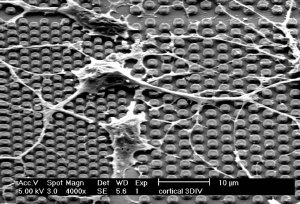IMEC presents a unique microchip with microscopic nail structures that enable close communication between the electronics and biological cells. The new chip is a mass-producible, easy-to-use tool in electrophysiology research, for example for fundamental research on the functioning and dysfunctioning of the brain. Each micronail structure serves as a close contact-point for one cell, and contains an electrode that can very accurately record and trigger in real-time the electrical activity of an individual electrogenic cell in a network.
 Caption: Cortical neurons engulf microscopic nail structures on the surface of IMEC’s micronail chip (3-day in vitro culture)
Caption: Cortical neurons engulf microscopic nail structures on the surface of IMEC’s micronail chip (3-day in vitro culture)
Electrogenic cells such as cardiomyocytes (heart cells) or neurons (brain cells) rely on electrical signals to communicate with one another. Knowledge of the electrical activity of these cells is essential to gain insights in the communication process of these cells, to unravel the cause of brain disorders such as Alzheimer’s or Parkinson’s disease, or validate the effect of drugs on cardiac cells in the struggle against cardiac diseases, etc. IMEC’s new micronail chip is the ideal instrument to study the communication mechanisms between cells. The electrodes in IMEC’s micronail chip are downsized to the size of cells and even smaller. They consist of tiny nail structures made of a metal stem covered with an oxide layer, and a conductive (e.g. gold or titaniumnitride) tip. When cells are applied on the chip surface, their cell membrane strongly engulfs the nail structures, thereby realizing an intimate contact with the electrode. This very close contact improves the signal-to-interference ratio enabling precise recording of electrical signals and electrical stimulation of single cells.
“We tackled several challenges to realize this micronail chip such as keeping the cells alive on the chip surface; combining the wet cell solution with the electronics underneath without destroying the electronics; guiding the cell growth so that the cell body is just on top of one individual electrode; and last but not least: bring the cells as close as possible to the chip surface. Now, we have a unique instrument to record and interpret the signals of the neurons. We can also stimulate neurons and follow up the consequences to unravel the functioning of our brain;” said Wolfgang Eberle, Group manager Bioelectronic systems.
Kris Verstreken, Director Bio-Nanoelectronics: “Few is known about the functioning of our brain. Where do emotions origin? How do we build up memories? Or what is the cause of brain diseases such as Parkinson’s disease or Alzheimer’s disease? Many processes in our brain are unknown. Neurons are very plastic cells, continuously forming new connections and breaking up or rebuilding new ones. But how do they do that? And which are the consequences for learning and development? On the long term, we can use the knowledge that we build up with in vitro experiments on our micronail chip to diagnose diseases, or even develop therapies, by stimulating cells, or building new communication bridges between cells after a brain infarct.”